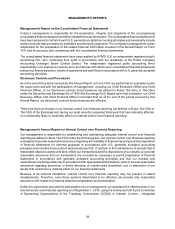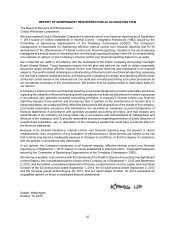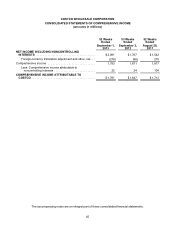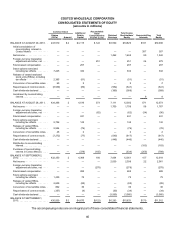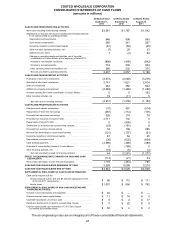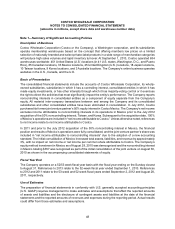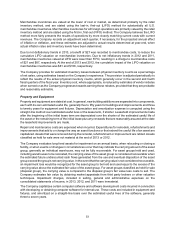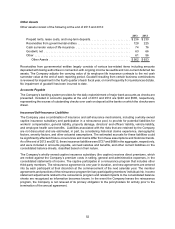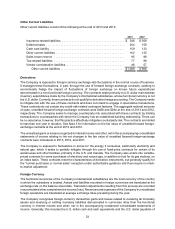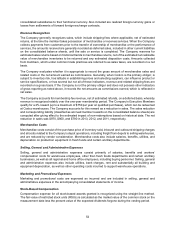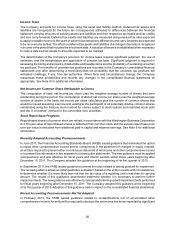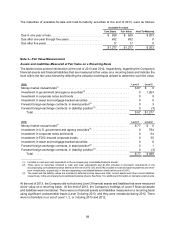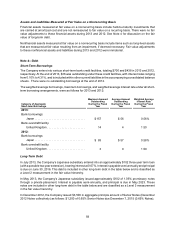Costco 2013 Annual Report Download - page 51
Download and view the complete annual report
Please find page 51 of the 2013 Costco annual report below. You can navigate through the pages in the report by either clicking on the pages listed below, or by using the keyword search tool below to find specific information within the annual report.49
Reclassifications
Certain reclassifications have been made to prior fiscal year amounts or balances to conform to the
presentation in the current fiscal year. These reclassifications did not have a material impact on the Company’s
previously reported consolidated financial statements.
Cash and Cash Equivalents
The Company considers as cash and cash equivalents all highly liquid investments with a maturity of three
months or less at the date of purchase and proceeds due from credit and debit card transactions with
settlement terms of up to one week. Credit and debit card receivables were $1,254 and $1,161 at the end
of 2013 and 2012, respectively.
Short-Term Investments
In general, short-term investments have a maturity at the date of purchase of three months to five years.
Investments with maturities beyond five years may be classified, based on the Company’s determination,
as short-term based on their highly liquid nature and because they represent the investment of cash that is
available for current operations. Short-term investments classified as available-for-sale are recorded at fair
value using the specific identification method with the unrealized gains and losses reflected in accumulated
other comprehensive income until realized. Realized gains and losses from the sale of available-for-sale
securities, if any, are determined on a specific identification basis and are recorded in interest income and
other, net in the consolidated statements of income. Short-term investments classified as held-to-maturity
are financial instruments that the Company has the intent and ability to hold to maturity and are reported net
of any related amortization and are not remeasured to fair value on a recurring basis.
The Company periodically evaluates unrealized losses in its investment securities for other-than-temporary
impairment, using both qualitative and quantitative criteria. In the event a security is deemed to be other-
than-temporarily impaired, the Company recognizes the credit loss component in interest income and other,
net in the consolidated statements of income. The majority of the Company’s investments are in debt
securities.
Fair Value of Financial Instruments
The Company accounts for certain assets and liabilities at fair value. The carrying value of the Company’s
financial instruments, including cash and cash equivalents, receivables and accounts payable, approximate
fair value due to their short-term nature or variable interest rates. See Notes 2, 3, and 4 for the carrying value
and fair value of the Company’s investments, derivative instruments, and fixed-rate debt, respectively.
Fair value is defined as the price that would be received to sell an asset or paid to transfer a liability (an exit
price) in an orderly transaction between market participants at the measurement date. Fair value is estimated
by applying a fair value hierarchy, which requires maximizing the use of observable inputs when measuring
fair value. The three levels of inputs are:
Level 1: Quoted market prices in active markets for identical assets or liabilities.
Level 2: Observable market-based inputs or unobservable inputs that are corroborated by market
data.
Level 3: Significant unobservable inputs that are not corroborated by market data.
The Company’s valuation techniques used to measure the fair value of money market mutual funds are
based on quoted market prices, such as quoted net asset values published by the fund as supported in an
active market. Valuation methodologies used to measure the fair value of all other non-derivative financial
instruments are based on “consensus pricing,” using market prices from a variety of industry-standard
independent data providers or pricing that considers various assumptions, including time value, yield curve,
volatility factors, credit spreads, default rates, loss severity, current market and contractual prices for the
underlying instruments or debt, broker and dealer quotes, as well as other relevant economic measures. All


